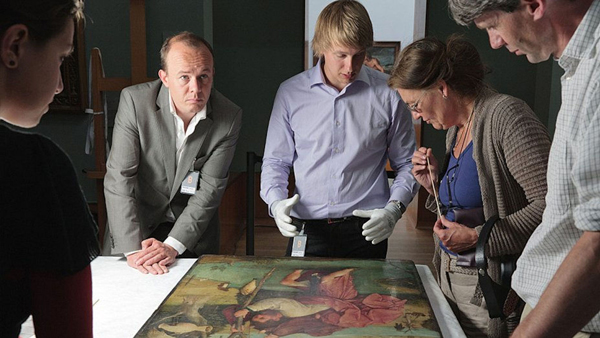Chances are that if you show a civilian a 500-year-old painting, they won’t be able to name the painter, unless it’s Bosch. His name is even listed as an adjective (“Boschian”) in online slang dictionaries. For somebody who produced fewer than 30 paintings in his lifetime, his legacy is outsized. The largest collection of his extant work is in the Prado Museum in Spain, but examples have found their way as far as Kansas City, Paris, Venice, New York and Washington DC. To commemorate the 500th anniversary of his death, a museum in his home town (Hertogenbosch in the Netherlands) decided to mount a retrospective of his work. Gathering paintings from around the globe for a show is a complex process involving courtship and loans. Happily, somebody decided to capture the process of assembling the show on film. The resulting documentary, Hieronymus Bosch: Touched by the Devil, tells us as much about museum machinations as it does about Bosch himself.
The film opens with an art expert counting the rings in the wood grain on the back of a painting. This shot announces that things are going to get very technical. The people wishing to stage the show and borrow paintings for it don’t have anything to offer in return, so many of the loans come with offers to restore the paintings they borrow. It is actually quite thrilling to watch a painting being cleaned under a microscope. Some of the paintings may not be painted by the hand of Bosch himself, so X-rays are taken of the under-drawings to compare known Bosch works against paintings that might be by him. Using this technology on a computer, they are able to do a screen wipe to show either the painting or the drawing underneath it. During these detail-oriented viewings, we are offered a number of fun little glimpses of how Bosch painted some of the details that might otherwise go unnoticed when looking at the whole painting. As one of the art historians points out, one normally views a Bosch painting in a crowded room with a velvet rope that keeps one five feet away from the work.
One source of narrative drama comes from the Prado’s decision to mount a competing show close enough to the home town show to prevent them from loaning his most famous work, The Garden of Earthly Delights. The filmmakers use some tropes of reality television. Individual art historians are filmed alone, talking about their hopes and disappointments (both about the show and in general).
The source of the greatest drama is the discovery and authentication of a previously unknown work. As the show comes together, we get to watch these rare works being packaged for transport. It can be a little jarring to see such familiar images as the fragile paint on wood that they are. Given how little we actually know of Bosch himself, this is a good reminder to artists that the work should speak for itself, without explanations or context.


